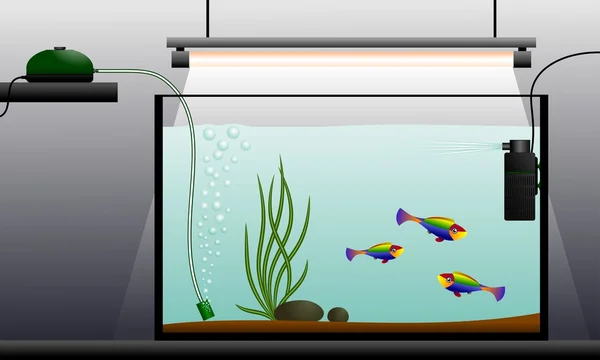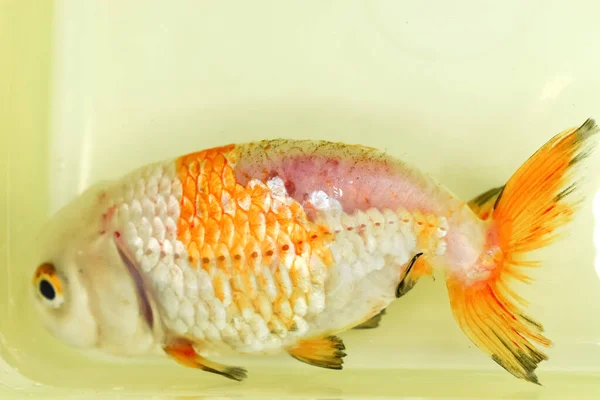Coming home to a floating, dead fish is one of the worst things that can happen to an aquarist. But finding your fish alive but twitching in the grip of a sudden seizure can be almost as bad.
Seizures can come on in seemingly mysterious ways, and there isn’t much information out there on how to treat them.
Can goldfish have seizures?
Let’s take a closer look at what seizures are and how to nurse a fish back to good health!
Can Goldfish Have Seizures?

Yes, goldfish can have seizures. In fact, any animal with a brain and nervous system could have a seizure. Seizures come from excessive abnormal electrical activity in the brain, causing the muscles and body to spasm uncontrollably.
Epilepsy is the most well-known example in people, but seizures can also be caused by an injury, disease, and even medications.
While goldfish are capable of having seizures, seizures in fish are a very understudied topic. The vast majority of seizure research goes into understanding and preventing them in humans. There is precious little information out there on true goldfish seizures, unfortunately.
Seizures When Death Draws Near
One time you might actually see true seizures is when a goldfish is close to death. As the brain starts to shut down in a dying fish, they may start to twitch and seize up.

The goldfish will likely be floating near the surface, slowly breathing. If this happens, there is nothing you can really do to help as it’s already dying and will be gone within minutes.
Symptoms Mistaken for a Seizure
Seizures are very, very rare in fish. Most of the time, when you see what looks like a seizure from without, you’re looking at a very different problem.
Even if the fish is twitching and writhing in the water, it’s a sign that there is a different issue. Fortunately, I’ll be going into great detail on identifying and treating the actual causes of these “seizures” below.
Some seizure-like symptoms to keep in mind include:
- floating and twitching uncontrollably near the surface
- fighting to swim and maintain buoyancy
- rapid shaking of the head and gills
- suddenly dashing around the fish tank
- crashing into or “flicking” against decorations
All of these movements have causes that usually aren’t seizure-related. So with this in mind, let’s talk about issues that are often mistaken for a seizure in goldfish!
Poor Water Quality

One reason why goldfish may act like they have seizures is because of poor water quality in your fish tank. High levels of nitrogenous waste products (ammonia, nitrite, nitrate) can all cause your fish severe skin and gill irritation.
These chemicals are all fatal if levels reach high enough concentrations, with ammonia being the worst and nitrate being the least.
Nitrate levels tend to be low but detectable in most aquarium water tests. Anything under 15 ppm is ideal, but goldfish easily tolerate up to 20-30 ppm of nitrate. Beyond that, your fish will have trouble breathing.
Nitrate displaces oxygen in the bloodstream, which will cause your fish’s gills to turn visibly brown. They will also start having seizures and spend all of their time near the surface trying to get as much oxygen as possible near the air.
Always perform a water test if it looks like your goldfish is having seizures. If ammonia, nitrite, or nitrate levels seem too high, then do an immediate water change to remove some of these agents and then re-test the water.
If you haven’t performed regular goldfish filter maintenance in weeks, now is an excellent time to clean it or buy new filter media.
Sudden Change in Water Parameters
Sudden shifts in water parameters are one of the most common issues mistaken for seizures. Goldfish will display all sorts of unusual behavior if the water chemistry is causing them stress.
Even when performing positive duties like a water change, you may see seizure-like activity in some cases.
Did You Dechlorinate the Water?

Forgetting to dechlorinate your freshwater during water changes is a major reason why fish may act like they experience seizures. Chlorine is a very helpful molecule and is used by municipalities to kill any bacteria that escape the water treatment process on the way to your faucet.
The amounts found in drinking water are harmless to us but still dangerous for aquatic life. Remember, chlorine gas was used as a weapon of war in World War 1.
Chlorine outgasses within 24 hours and is not always in levels high enough to outright kill a tank of fish, especially larger goldfish. But smaller fish are often more sensitive to dissolved chlorine levels.
When chlorine remains in the tank water, you will often see your fish begin to flick about quickly. Their gills are receiving chemical burns from the dissolved chlorine, which can cause them to twitch and display seizure-like behaviors.
Some municipalities add chloramine to the water instead. Chloramine is even more problematic because it doesn’t disappear so quickly. You should always be using a tap water conditioner every time you perform an aquarium water change to ensure these chemicals don’t harm or kill your goldfish.
What is the Water Temperature?
Sudden shifts in water temperature are how many fish end up showing seizure behavior. When you add fresh water after a water change, do you monitor how different the water temperature inside the tank is from the incoming water?
You should be using a thermometer to get the temperatures as close as possible to one another. 2 to 4 degrees Fahrenheit is an acceptable difference when performing a water change of 20% or more.
Any more and you may see your fish begin to twitch and dart around from temperature stress, similar to seizures.
The only difference is if you are performing a small water change for a larger tank size. If you have a 55-gallon tank and only do a 5-10% change, the water temperature will not shift all that much, even if the water is many degrees colder or warmer.
Smaller tanks – and larger changes for larger tanks – are where your fish are most sensitive to temperature shifts.
An Unseen Injury
If you’ve noticed your fish having seizures take some time to study its skin and how it is swimming. Many fishes react with seizures from the pain of a fresh injury. Wounds from a territorial tank mate, parasites, or scratches against decorations can all cause a stress or pain response in goldfish.
The injury does not even need to be big. Missing scales might indicate a wound that did not break the skin but is still painful. In this case, it is normal for your goldfish to show odd behavior until the wound reseals itself.

If your fish has an open wound, then first try to discover the cause of the injury. Once your fish is safe from future damage, add an antibacterial remedy like Melafix to prevent infection and speed healing!
Illness and diseases are also often mistaken for seizures. If you see your goldfish darting around the tank or flicking its sides against decorations, it’s likely trying to scratch an itch. Parasitic infections like ich and gill flukes can cause constant irritation as they feed on the blood of your goldfish.
Fortunately, parasites usually respond very quickly to medications used on the fish tank. The aquarist in this video does a great job of demonstrating how to diagnose and treat a parasitic infection in her goldfish!
Wrapping Things Up

As you can see, seizures in fish aren’t quite the same as they are in humans. When you see a goldfish having what looks like a seizure, it’s much more likely to be indicating an issue about your fish tank environment.
Poor water quality, toxic chemicals, injuries, and other issues are usually the reason for a “seizure.” Hopefully, the information in this guide will help you figure out which fish tank problem you’re dealing with and treat it quickly!
Frequently Asked Questions:

